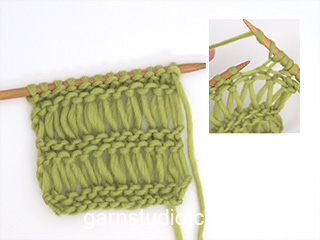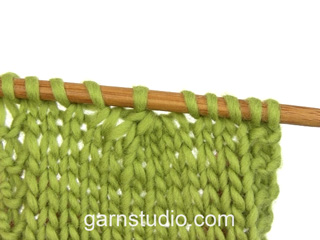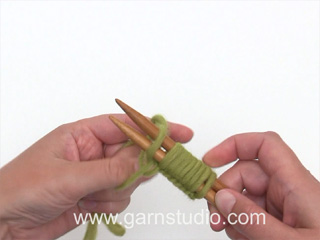Cloud Cover Cardigan |
||||||||||||||||||||||
 |
 |
|||||||||||||||||||||
Knitted jacket with popcorn and bobbles in DROPS Melody. Size XS–XXL.
DROPS 220-10 |
||||||||||||||||||||||
|
------------------------------------------------------- EXPLANATION FOR THE PATTERN: ------------------------------------------------------- GARTER STITCH (back and forth): Knit all rows. 1 ridge vertically = knit 2 rows. PATTERN: See diagrams A.1 and A.2. Diagrams show all rows in pattern seen from the right side. BIND-OFF TIP: To avoid a tight bind-off edge you may use a larger needle size. If this also is too tight, work a 1 yarn over after approx. every 4th stitch while binding off (bind off yarn overs as regular stitches). ------------------------------------------------------- START THE PIECE HERE: ------------------------------------------------------- JACKET - SHORT OVERVIEW OF THE PIECE: Work back and front piece back and forth on circular needle separately, bottom up. Sew piece together on the shoulders. Then pick up stitches along armholes. Sleeves are worked back and forth on circular needle, top down. Sew piece together as explained in pattern. Work a neck edge in garter stitch at the end. BACK PIECE: Place circular needle size 7 = US 10,75 and 8 MM = US 11 together and cast on 54-60-66-72-78-84 stitches over both these circular needles with Melody – this is done to avoid a tight cast-on edge. Pull out circular needle size 8 MM = US 11 from the stitches, and work in GARTER STITCH back and forth on circular needle size 7 MM = US 10.75 - read explanation above. When piece measures 6 cm = 2⅜", switch to circular needle size 8 MM = US 11. Work next row as follows from right side: Work A.1 (= 3 stitches), work A.2 over the next 48-54-60-66-72-78 stitches (= 8-9-10-11-12-13 repetitions of 6 stitches), and finish with A.1 (= 3 stitches). Continue pattern back and forth like this. REMEMBER THE KNITTING GAUGE! When piece measures 46-46-48-47-49-49 cm = 18"-18"-19"-18½"-19¼"-19¼", bind off 2-2-2-8-8-8 stitches for armholes at the beginning of the next 2 rows = 50-56-62-56-62-68 stitches. Continue pattern as before but work A.1 over only 1 stitch in each side When piece measures approx. 57-59-61-63-65-67 cm = 22½"-23¼"-24"-24¾"-25½"-26⅜" – finish after one whole repetition,vertically work in garter stitch back and forth over all stitches. When piece measures 62-64-66-68-70-72 cm = 24⅜"-25¼"-26"-26¾"-27½"-28⅜", bind off the middle 16-18-18-20-20-22 stitches for neck and finish each shoulder separately. Continue with garter stitch and bind off 1 stitch on next row from neck = 16-18-21-17-20-22 stitches remain on shoulder. Continue to work until piece measures 64-66-68-70-72-74 cm = 25¼"-26"-26¾"-27½"-28⅜"-29⅛". Bind off by knitting from right side - read BIND-OFF TIP! Work the other shoulder the same way. RIGHT FRONT PIECE: Place circular needle size 7 = US 10,75 and 8 MM = US 11 together and cast on 33-36-39-42-45-48 stitches over both these circular needles with Melody. Pull out circular needle size 8 MM = US 11 from the stitches, and work in garter stitch back and forth on circular needle size 7 MM = US 10.75. When piece measures 6 cm = 2⅜", switch to circular needle size 8 MM = US 11. Work next row as follows from the right side (i.e. from mid front): Work A.1 over the first 6-9-6-9-6-9 stitches (= 2-3-2-3-2-3 repetitions of 3 stitches), work A.2 over the next 24-24-30-30-36-36 stitches (= 4-4-5-5-6-6 repetitions of 6 stitches), and finish with A.1 (= 3 stitches). Continue pattern back and forth like this. When piece measures 46-46-48-47-49-49 cm = 18"-18"-19"-18½"-19¼"-19¼", bind off 2-2-2-8-8-8 stitches for armholes at the beginning of next row from wrong side = 31-34-37-34-37-40 stitches. Continue pattern as before but work A.1 over only 1 stitch in the side towards armhole When piece measures approx. 57-59-61-63-65-67 cm = 22½"-23¼"-24"-24¾"-25½"-26⅜" – finish after one whole repetition,vertically work in garter stitch back and forth over all stitches. When piece measures 59-61-63-64-66-68 cm = 23¼"-24"-24¾"-25¼"-26"-26¾", slip the first 11-12-12-13-13-14 stitches at beginning of row from mid front on a stitch holder for neck, but work them before slipping them on stitch holder to avoid cutting the yarn. Continue with garter stitch and bind off for neck at the beginning of every row from neck as follows: Bind off 2 stitches 1 time and 1 stitch 2 times = 16-18-21-17-20-22 stitches remain on shoulder. Continue to work until piece measures 64-66-68-70-72-74 cm = 25¼"-26"-26¾"-27½"-28⅜"-29⅛". Bind off by knitting from right side - read BIND-OFF TIP! LEFT FRONT PIECE: Place circular needle size 7 = US 10,75 and 8 MM = US 11 together and cast on 33-36-39-42-45-48 stitches over both these circular needles with Melody. Pull out circular needle size 8 MM = US 11 from the stitches, and work in garter stitch back and forth on circular needle size 7 MM = US 10.75. When piece measures 6 cm = 2⅜", switch to circular needle size 8 MM = US 11. Work next row as follows from the right side (i.e. from the side): Work A.1 (= 3 stitches), work A.2 over the next 24-24-30-30-36-36 stitches (= 4-4-5-5-6-6 repetitions of 6 stitches), and finish with A.1 over the last 6-9-6-9-6-9 stitches towards mid front (= 2-3-2-3-2-3 repetitions of 3 stitches). Continue pattern back and forth like this. When piece measures 46-46-48-47-49-49 cm = 18"-18"-19"-18½"-19¼"-19¼", bind off 2-2-2-8-8-8 stitches for armholes at the beginning of next row from right side = 31-34-37-34-37-40 stitches. Continue pattern as before but work A.1 over only 1 stitch in the side towards armhole When piece measures approx. 57-59-61-63-65-67 cm = 22½"-23¼"-24"-24¾"-25½"-26⅜" – finish after one whole repetition,vertically work in garter stitch back and forth over all stitches. When piece measures 59-61-63-64-66-68 cm = 23¼"-24"-24¾"-25¼"-26"-26¾", slip the first 11-12-12-13-13-14 stitches at beginning of row from mid front on a stitch holder for neck, but work them before slipping them on stitch holder to avoid cutting the yarn. Continue with garter stitch and bind off for neck at the beginning of every row from neck as follows: Bind off 2 stitches 1 time and 1 stitch 2 times = 16-18-21-17-20-22 stitches remain on shoulder. Continue to work until piece measures 64-66-68-70-72-74 cm = 25¼"-26"-26¾"-27½"-28⅜"-29⅛". Bind off by knitting from right side - read BIND-OFF TIP! ASSEMBLY-1: Sew shoulder seams inside bind-off edge. SLEEVES: Now pick up stitches along the armhole as explained below, i.e. From bottom of armhole and up to shoulder, and from shoulder and down to armhole on the other side - work sleeves top down. Pick up from right side approx. 42-48-48-54-54-60 stitches inside 1 edge stitch on circular needle size 8 MM = US 11 with Melody. Knit 1 row from wrong side. Work next row as follows from right side: Work A.1 (= 3 stitches), work A.2 over the next 36-42-42-48-48-54 stitches (= 6-7-7-8-8-9 repetitions of 6 stitches), and finish with A.1 (= 3 stitches). Continue pattern back and forth like this. When sleeve measures 2-2-2-7-7-7 cm = ¾"-¾"-¾"-2¾"-2¾"-2¾" from where stitches were picked up, insert 1 marker in each side. Markers mark where sleeves are sewn to the bottom of armhole. NOW MEASURE PIECE FROM HERE! Continue back and forth as before. When sleeve measures 4 cm = 1½" from markers, decrease 1 stitch at the beginning of row by knitting 2 together. When piece measures 8 cm = 3⅛", decrease 1 stitch at the end of row by knitting 2 twisted together = 40-46-46-52-52-58 stitches. Repeat decrease in size L, XL and XXL at the beginning of row when sleeve measures 12 cm = 4¾" from marker, and at the end of row when sleeve measures 16 cm = ⅜" from markers = 40-46-46-50-50-56 stitches. Continue pattern as before but work A.1 over only the outermost 2-2-2-1-1-1 stitch in each side Work until sleeve measures approx. 46-45-44-42-41-39 cm = 18"-17¾"-17¼"-16½"-16⅛"-15¼" from marker – finish after one whole repetition vertically. Switch to circular needle size 7 MM = US 10.75. Work in garter stitch back and forth until sleeve measures 48-47-46-44-43-41 cm = 19"-18½"-18"-17¼"-17"-16⅛" from markers, or desired length. Bind off by knitting from right side - remember BIND-OFF TIP! ASSEMBLY-2: Sew sleeves to bottom of armhole – markers on sleeve should fit side on front piece/back piece Sew underarm seams and side seams in one - begin at the bottom of sleeve and sew seam up to armhole (in outer loops of edge stitches to avoid a chunky seam), then continue seam from armhole and down along front/back piece. Repeat in the other side of piece. NECK EDGE: Pick up from right side approx. 56 to 78 stitches around the neck (including stitches on stitch holders at the front) on circular needle size 7 MM = US 10.75 with Melody. Knit 1 row from wrong side, knit 1 row from right side and knit 1 row from wrong side. Bind off by knitting from right side - remember BIND-OFF TIP! |
||||||||||||||||||||||
Diagram explanations |
||||||||||||||||||||||
|
||||||||||||||||||||||

|
||||||||||||||||||||||
|
Have you made this or any other of our designs? Tag your pictures in social media with #dropsdesign so we can see them! Do you need help with this pattern?You'll find tutorial videos, a Comments/Questions area and more by visiting the pattern on garnstudio.com. © 1982-2024 DROPS Design A/S. We reserve all rights. This document, including all its sub-sections, has copyrights. Read more about what you can do with our patterns at the bottom of each pattern on our site. |
||||||||||||||||||||||





































































Comments / Questions (17)
Beskrivelsen på popcorn i oppskriften og på videoen samsvarer ikke. Videoen viser det mye bedre- beskrivelsen burde vært endret
02.08.2023 - 13:23Hei! Flott jakke! Men kvar finn eg diagrammet til mønsteret? På min mobil kjem berre forklaringa til dei forskjellige teikna fram (også om eg veljer "skrivebordsvising"). HK
06.03.2021 - 11:04DROPS Design answered:
Hei HK, Diagrammene er til høyre for målskissen på bunnen av oppskriften. God fornøyelse!
08.03.2021 - 07:23Kevyt kuin pilvenhattara
19.01.2021 - 23:44Myk sky
14.01.2021 - 16:39Retro
14.01.2021 - 03:08I totally agree with the retro comment; I chose it for that very reason.
14.01.2021 - 03:05Varm tåke
11.01.2021 - 20:00I suggest: Snow in May
10.01.2021 - 22:44Suggested name: Thistledown
10.01.2021 - 21:39So beautiful and a bit retro. I NEED to make this!!
10.01.2021 - 11:48